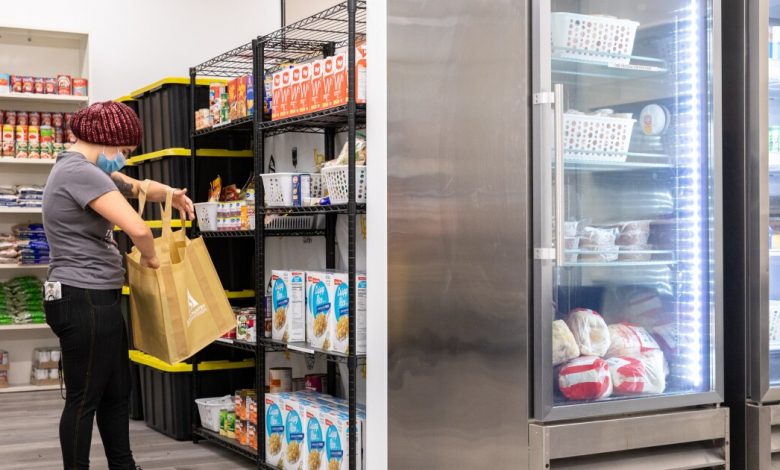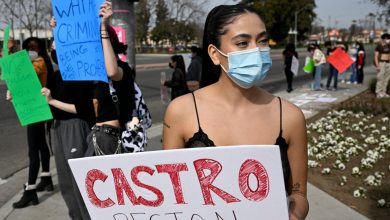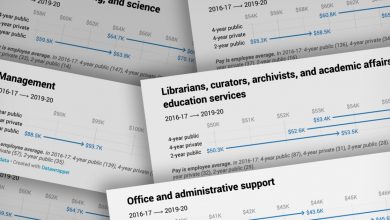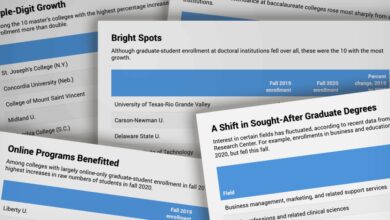Students Are Struggling With Basic Needs. So Colleges Are Tapping ‘Benefits Navigators.’

The three students at Oregon Coast Community College needed help. To finish their degrees, they had to complete an internship this past spring, which required driving to a nearby internship site. But gas was $6 a gallon.
That’s when Tracy Jones stepped in. As the student-resource navigator at Oregon Coast, Jones helps students who are facing financial barriers that could derail them academically. She gave each of the three students a $100 gift card for gas.
“They were able to get there, get their hours in, and then graduate,” she said. “And now they are moving on.”
Benefits navigators like Jones are popping up on college campuses across the country. They help students apply for federal, state, and local assistance; connect them with food pantries and other resources; and provide them with emergency aid when times get tough. Illinois, Oregon, and California passed laws in the past year requiring a benefits navigator — and, in California’s case, a physical basic-needs center — on every public college campus in the state.
When Cristina Pacione-Zayas was in college, navigating available resources was a challenge, she said. Pacione-Zayas, now an Illinois state senator, sponsored the bill that recently became law there.
“You needed to have a certain level of persistence because you would need to go to the financial-aid office for this, go to the office of minority student affairs for that, go to the health clinic for something else,” Pacione-Zayas said. “This is going to help streamline the university and college experience for the ever-growing, diverse, lived experiences that college students are bringing to campuses.”
But the navigators often struggle to provide all of the help that students need. They cite a lack of discretionary funding, difficulties with student outreach, and lack of resources available — especially in the context of rent spikes and widespread student-housing shortages — as major obstacles.
Jones recently saw two Oregon Coast students drop out “due to multiple barriers that, with my limited budget, I was not able to help them overcome,” she said. “Being in an extremely rural, low-income county, benefits programs are few and far between.”
Another challenge is that, often, a single administrator can’t keep up with the caseload. So some larger colleges are moving away from that model and building a peer-based network instead. Rise, a national organization that trains and funds student-benefits navigators, is partnering with colleges like Illinois State University to scale up peer support.
“Research in the social-work profession has repeatedly demonstrated that people are more likely to utilize services that are recommended by their peers,” Stacy Raphael, case manager at Rise, said. “And students just relate better to each other. There is a cultural divide between adult administrators and certainly traditional-aged college students.”
Helping ‘Students Who Are Alone’
Illinois and California are still in the hiring and planning stages for their benefits navigators, with laws that passed or went into effect this summer. In Oregon, benefits navigators have a semester or two of service already under their belt.
Alana Strickland, benefits navigator at Klamath Community College, spends her day building connections with community organizations and meeting with students on a case-by-case basis — through self-referrals or referrals from professors — to address their needs. She also participates in a statewide consortium with other campus benefits navigators.
“Students don’t always know about all the support systems that are available to them, so some may not even think about asking their institutions for assistance in their personal lives,” Strickland said. “I’ve met with many students who are alone and lack a support system, like they’re a single parent, or they just moved here and they have no family or no support.”
She’s currently organizing a blanket drive with the local Salvation Army to “stock up” for winter. She received a supply of $20 vouchers for Goodwill. And she’s signed Klamath up for a partnership with Temple University’s Hope Center for College, Community, and Justice to learn more about best practices for supporting students’ basic needs.
Strickland said much of her impact is direct. She helped one student who was fleeing domestic violence get funding to enroll in the college’s GED program, a free laptop and Wi-Fi hotspot device, and a $500 scholarship.
“So far, they completed one term of the GED program and they’re now currently in the summer term,” Stickland said of the student. “And they’re working on becoming dual-enrolled to start credit courses that jump-start their future career goals.”
At Oregon Coast Jones said, she spends most of her time online doing research about what benefits are available. “They might be there today, but tomorrow they’re full and cannot accept any more referrals,” she said.
Jones also meets with students one on one. “Sometimes I’m just the sounding board for students who are having a bad day and just need someone to talk to,” she said.
All community colleges and public universities in Oregon have designated a benefits navigator, but the approach varies by institution, said Elizabeth Guzman Arroyo, statewide director of STEP and Pathways to Opportunity. Both organizations are housed at Portland Community College, where Guzman Arroyo works, and focus on expanding access to higher education and economic mobility by bolstering public assistance. Guzman Arroyo is collecting data to measure how effective the benefits navigators are.
Some colleges have also adopted a single-stop model, where one center houses multiple staff members to connect students to public benefits.
“The model that’s most effective really depends on the institution type,” Guzman Arroyo said, according to the data they have seen so far. “A small case-management model is super effective in a smaller school, but a peer program or a single-stop model tends to be a little bit more effective in a larger school when you have a larger population of students to serve.”
Peer-to-Peer Model
Illinois State’s team of peer navigators, trained by Rise, will begin their work this fall. The student network will specifically target food insecurity.
Oregon State University already had a benefits navigator in place when its state bill was passed. But the university switched to a peer-to-peer model, like Rise’s, after three years.
“We saw a lot of limits to his impact — often he was scheduled a month or more out,” said Nicole Hindes, director of Oregon State’s Basic Needs Center, in an email about the former benefits navigator. The peer model is designed to “increase the amount of support hours we have available for students and to create a ‘drop-in anytime’ approach that also impacts some of the stigma issues,” she wrote.
Hunter M. Calvert, a student leader at the Oregon State center, said students also sometimes shy away from telling administrators how much they are struggling. “I think students in particular have kind of been taught to maybe not advocate for themselves as strongly in the face of authority,” he said.
Calvert is one of four student leaders and 16 student staff members working at the center. They see students on a case-by-case basis, like Jones and Strickland, and also run the weekly campus food pantry and other events.
The benefit of employing students is twofold, Calvert said. When it comes to benefits navigators, “it’s great to have one, but it’s better to have 16,” he said. And students who work in the center are given “this immense opportunity to learn and be imperfect and make mistakes, but also to be successful and grow into basic-needs navigators.”
Over the past year, Rise has built 10 partnerships with colleges across the nation, from Los Angeles Valley College to the University of Wisconsin at Madison. Most of the new student networks are starting up this fall, Raphael said. The organization hires students, trains them in multiple skill sets like case management and trauma-informed care, and works with colleges to pay them $15 per hour, often in conjunction with the federal work-study financial-aid program.
Raphael said there just “isn’t enough staff capacity” to address increasing basic-needs concerns. Student-focused models can be a solution, she said, or at least an extra layer of support.
Lack of Resources
But no matter the model, benefits navigators aren’t always able to help students in the way they want to.
Strickland said a lack of funding is the main barrier she faces to fully supporting students. Oregon’s legislation gave $5 million to be distributed among community colleges and universities to support benefits navigators. But the grants can’t be used to provide direct financial support, she said.
“We can spend our grant for marketing, outreach, supplies like office equipment, training, and things like that,” she said. “And so then you have a student who needs support right then and there, but there’s no funding left, or a student’s needs may be higher than what a program’s limits allow for.”
Oregon Coast Community College wasn’t able to give Jones a budget for emergency aid. Jones applied for grants to fill the gaps, earning two for $5,000 a piece.
“So up until next April, I have $10,000 to help my students,” she said. “But when you have, you know, 500 students, $10,000 doesn’t go very far, which is why I have to limit to ‘You get $100,’ or ‘You get your utilities paid,’ and it’s kind of a one-time shot.”
Jones wishes that the state had done more to accommodate small cash-strapped colleges like hers. “But when they created these positions, they should have at least looked at smaller colleges like OCCC that don’t have the funds to have discretionary funding,” she said. “They could have created some funding to go along with it because even a small amount can help.”
Meanwhile, California’s law gave more than 130 community colleges in the state a shared one-time allocation of $100 million plus $40 million yearly, with additional funding given based on the number of students who are low-income or receiving Pell Grants. All community colleges in the state have either hired or identified staff to implement basic needs centers, Melissa Villarin, a spokesperson for California Community Colleges, said in an email.
The California State and University of California systems, which have had student basic-needs programs in place for years, receive recurring state funding of $15 million and $18.5 million, respectively.
No additional funding for colleges was allocated under the Illinois bill. “But it doesn’t say that they have to hire a new person” as the benefits navigator, said Pacione-Zayas, the state lawmaker. “It just says that there needs to be an identified individual or role that would take on these responsibilities.”
Even when benefits navigators can find the money, they are often constrained by the availability of the actual resources.
Strickland said housing is her students’ top need. But there aren’t enough options for her to pull from. “It’s hard because I want to help, but I can’t just go make housing available,” she said.
Finding a house is difficult enough — but finding one that follows regulations for vouchers is an extra challenge. “I even had one student where I think the voucher was for $736 and they found a place for $750,” Strickland said. “But they couldn’t get that place just because it didn’t follow the guidelines.”
Often, the barriers begin with students who refuse to accept help. This happens especially in the cases of housing insecurity, said Henoc M. Preciado, systemwide manager for the Basic Needs Initiative at California State University.
“What we hear sometimes is students thinking like: ‘I’m okay with couch surfing like this. This works for me,’” he said. “And although it’s still considered housing insecurity, the student is not wanting to accept the support because they feel that there’s someone else who needs it more.”
Jones said that “sometimes pride gets in the way,” too. She has often heard students say: “I don’t need help. And I will not sign up for SNAP benefits. I will do this on my own.”
Strickland said that at her college, students are deterred from seeking help because there is no one-stop hub for services. Just this week, she met with a student who admitted they did not get help earlier because of anxiety.
“So if there’s other students in the same boat, it might be beneficial for all student-support resources to be located in one area on the college campus,” Strickland said. “That way, if they were to come in, they can meet everybody in one place.”
Benefits navigators and leaders also worry that the stigma surrounding public assistance will prevent students from seeking their help. Calvert, the Oregon State senior, is trying to combat that stigma with better outreach.
“We want to communicate in a way so that students have no shame in coming in and getting care,” Calvert said.
Normalizing Basic-Needs Assistance
Preciado has noticed the stigma associated with applying for support on California State’s 23 campuses, too. To normalize these efforts, faculty and campus leaders are given training as basic-needs ambassadors.
Faculty are also encouraged to include information about services in their syllabuses “in the same way that we provide a statement on ADA accessibility for students in need of additional support.”
“Food pantries and this level of support is a very normal part of life,” Preciado said. “And it’s being offered on our college campuses in the same way that it’s being offered outside of our campuses.”
When addressing students who reject help because they feel others need it more, Preciado said it’s important to remind them that “accepting support is not taking away support from anyone else.”
“We want to support all the students in the best ways possible because we want to be able to tell our funders, the legislature, the community, what the level of need is so that we can continue to be well-resourced to continue to do this work,” he said.
Reflecting on Cal State’s years of experience with benefits navigators, Preciado said that partnering with off-campus, longstanding community organizations is key. “Supporting students’ basic needs is not the work of a unit or an individual, it is the work of an entire community,” he said.
In Oregon, Guzman Arroyo hopes the data they are collecting, which will be released next June, will help inform state lawmakers. The data will capture demographics of students being served in Oregon, the needs they are experiencing, and the actual help they were able to receive.
“But then also, we will be able to take the data around what we weren’t able to connect students with and utilize that data for new legislation or influence on policy that legislators here in Oregon might be thinking through passing.”
Strickland and Jones both anticipate that their number of student cases will increase in the fall semester, especially as more students transition from online learning and awareness of their services spreads. They also hope to expand their connections with community resources.
“A lot of people don’t even know that we’re here in the community,” Jones said. “By educating the community partners and the students, I’m hoping to be able to broaden what I can do.”
Over the next academic year, Jones is going to stretch her limited grant money as far as it can go. “Even a $100 gift card to Fred Meyer, just because it has both food and gas, can make a real difference in some of these students’ lives.”
Source link






